As a fruit-based human, some things hit home when seeing our primate cousins in captivity! Being aware of our tropical origin, the reason for our sweet tooth, and what a frugivore’s diet actually looks like and requires, I felt disappointed to find that some zoos feed their primates sub-optimal foods – and their determination to cut out fruits! Tropical fruits are the main food source of apes and primates in nature, which is why it’s not species-appropriate to keep this food at a minimum in captivity – it actually makes no sense at all!
This article is a voice for primates in captivity and their species-specific diet to raise awareness about frugivory in apes. And to point out misperceptions among caretakers that try to do their best for those beautiful and sentient animals.
Zoos in colder climates: Are apes really being fed according to their species’ needs?
In captivity, apes show degenerative conditions and behavioral problems (see examples here and here). Factors might be:
- Being fed an unnatural diet (see below)
- Receiving medications like contraceptives
- Lack of opportunities to self-medicate or naturally supplement their diet with herbs and minerals, like they do in the wild
- Less physical activity, boredom and depression
- Being kept in the wrong climate
Let’s start with the diet:
Is the diet of apes – as frugivores – being misunderstood?
What do chimpanzees (for example) actually eat in the wild? Our closest relatives are frugivores, not typical omnivores, which is well-documented by academic research and primatologists! To be precise, the universally accepted classification is frugivorous omnivores or sometimes omnivorous frugivores.
Apes in general eat a diet high in ripe, sweet, tropical fruits – and thus naturally occurring simple sugars – yes, the same sugars that we are being told are “toxic” in today’s nutritional “confusion”!
Overview of the average chimpanzee diet in the wild
Summary of the Chimpanzee Diet of the Jane Goodall Institute
70% tropical fruits and figs
24% other plant-based foods (flowers, nuts, leaves, seeds, barks, tubers)
6% animal-based (eggs, insects, and meat)
4% insects
1-2% meat
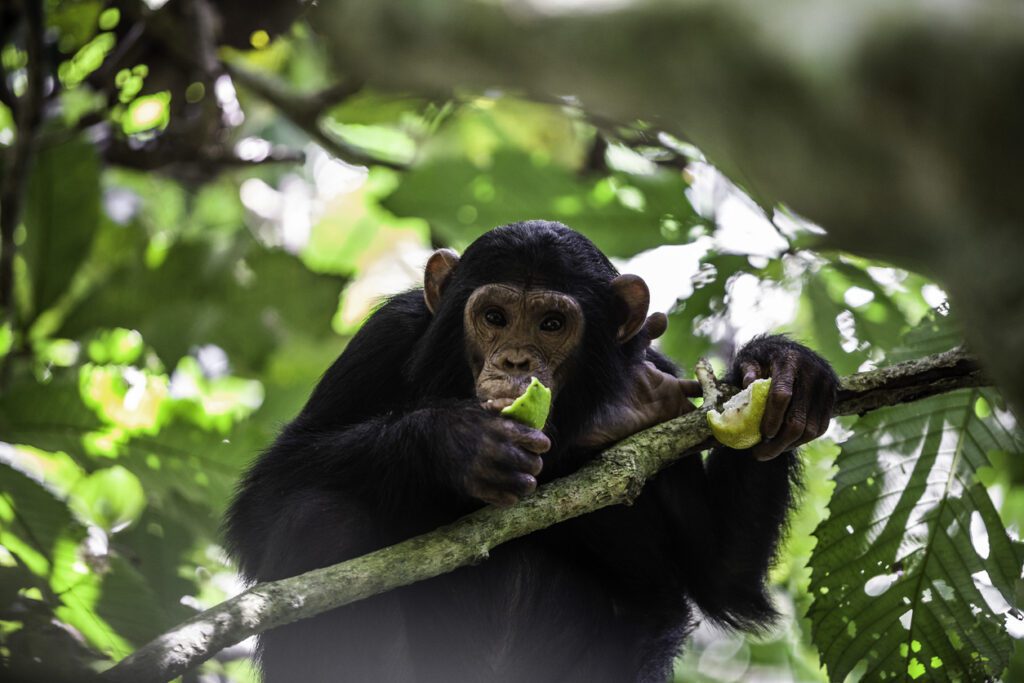
Weirdly, some zoos seem not to understand the fruit-based diets of great apes: frugivory is still largely unknown compared to omnivory or carnivory! A situation with sad consequences for the ape’s well-being… But why is it so hard to grasp that primates are tropical frugivores in the wild, which need sweet tropical fruits as the main food source – also in captivity?
The answer might go deeper than we think: a misguided dietary picture of our closest relatives as omnivores – instead of frugivores – has been promoted for a few decades (read more here). And why? Once more, it might be profit-driven, covering up the real natural diets of apes, including the human diet… But let’s start at the beginning.
The first problem is the “sugar myth”: Primates need more wild tropical fruits!
The weird idea that sugar and sweet fruits are harmful (the “war on sugar“) to humans (a totally dogmatic nutrition fad) seems to have spread to the poor, fruit-loving monkeys and apes in some zoos. Maybe to keep this dietary lie alive, instead of learning what a more natural, species-appropriate diet of humans looks like – a frugivorous diet! After all, if apes are omnivores, we must be too, right?! We possibly could not be a species with a diet high in sweet fruits and only small percentages of other foods. Where is the money in that…
But who suffers the consequences of this lie, are the primates being deprived of their natural food source, chewing on green vegs and low-carb fruits and foods (which should only serve as an addition to fruits!) in captivity?
Desperate monkeys for sweet fruits – but no more bananas?
In many zoos, the diet of primates, who have no access to abundant tropical fruits, does not come close to what the animals eat in their natural habitat. However, this is not solely a lack of resources (it is expensive to get hands-on high-quality ripe, tropical fruits in colder climates) but also an ignorance when it comes to basic knowledge about simple sugars in fruits as an energy source – the natural energy source for frugivores!
Some zoos have sadly gone as far as banning bananas and feeding the animals – which have evolved with sweet fruits – with non-sweet veggies and greens:
“Paignton Zoo in Devon is grabbing bananas out of its monkeys’ hands, giving them leafy veggies and sprouts instead.”
CNN, 2014
Non-sweet vegetables cannot substitute wild tropical fruits, as has been suggested for captive primate nutrition, as they have another nutritional profile than wild tropical fruits, and most food species are not – originally – primate foods. Wild fruits differ in their sugar profile from cultivated ones but are sweet and primarily fructose-dominant. Thus, the explanation that cultivated bananas are sweeter than wild ones does not excuse or justify banning them altogether or actually substituting supermarket bananas with higher-quality wild bananas. Isn’t creating a species-appropriate environment a duty of zoos?
The lack of high-quality tropical fruits in colder climates is not really surprising, considering humans themselves have to eat fallback foods living in colder climates. But then… is it really ethical to keep apes in captivity if you cannot provide their natural foods? (Disclaimer: I am obviously not talking about sanctuaries or rescue stations of apes which are located near the natural habitat of primates).

Primates have a sweet tooth for a good reason – they are highly frugivorous. In the wild, loving sweet is how primates (including apes and humans) identify energy sources and get the right ripe fruits.
No wonder, at my last zoo visit, a monkey stole a kid’s lollipop candy and screamed for his life when they took it away from him – the sweet-loving creature was otherwise being fed mostly acidic, temperate fruits like apples and kiwis instead of sweet, tropical fruits that are actually natural food source of primates in nature – we are talking bananas, figs, passion fruit, and other tropical fruits.
Sadly, a (wrong) interpretation of primates’ love for candy is that the craving is a harmful sugar addiction – rather than the important instinct that helps us to forage for fruits. We have evolved to feel appealed by fruits and sweetness and to identify our “matching” food source.
However, the argument of the zoos, that cultivated bananas are not equal to wild bananas is actually valid– and a real problem also for humans. But giving primates no more bananas and feeding them non-sweet veggies and acidic fruit is not a species-appropriate way to keep them.
High-quality bananas as a vitamin B12 source?
Lately, bananas are being mentioned as a plant-based source of vitamin B12 – which is very surprising, given that B12 is found in animal-based foods and is produced by microorganisms! Do bananas really contain vitamin B12? Recent studies describe banana pulp and peel as a source of vitamin B12. See here, here, and here. A vitamin B12-containing fruit is something that would contribute to a shift in dogma concerning B12 and plant-based nutrition. I can’t fully grasp the idea of a B12-containing fruit yet – it’s too good to be true! Read more about bananas.
Traditionally, bananas were used to combat anemia, which could be due to two key nutrients for blood building: iron and vitamin B12. The iron content is sometimes described as low and sometimes as high. Such contradicting information is not surprising considering the differences in the quality of the fruits. I assume that the vitamin B12 content of bananas is variable, too, and I would not consider them a reliable source, especially if you cannot get high-quality produce. Further, there is a lack of information on the bioavailability of the B12 found in bananas.
This topic is also highly relevant for plant-based diets, and more research on whether bananas can be a B12 source for humans would further aid in understanding the human diet and the role of tropical fruits in it!
B12 in bananas also would be a possible factor in increased coprophagy and B12 deficiency in primates in zoos!
Primates are being fed dry food “monkey chow”
Instead of their natural foods, tropical fruits, primates are given highly processed junk foods! Usually, primate pellets and biscuits (“monkey chow”) are based on grains like corn, soybean, and oats, with added oils, vitamins, and minerals – which are all ingredients that are not naturally found in primates’ diets! Feeding guidelines (see below) vary depending on who is establishing them. However, the recommendations are usually a diet based on pellets and veggies instead of fruits (see examples here, here, and here).
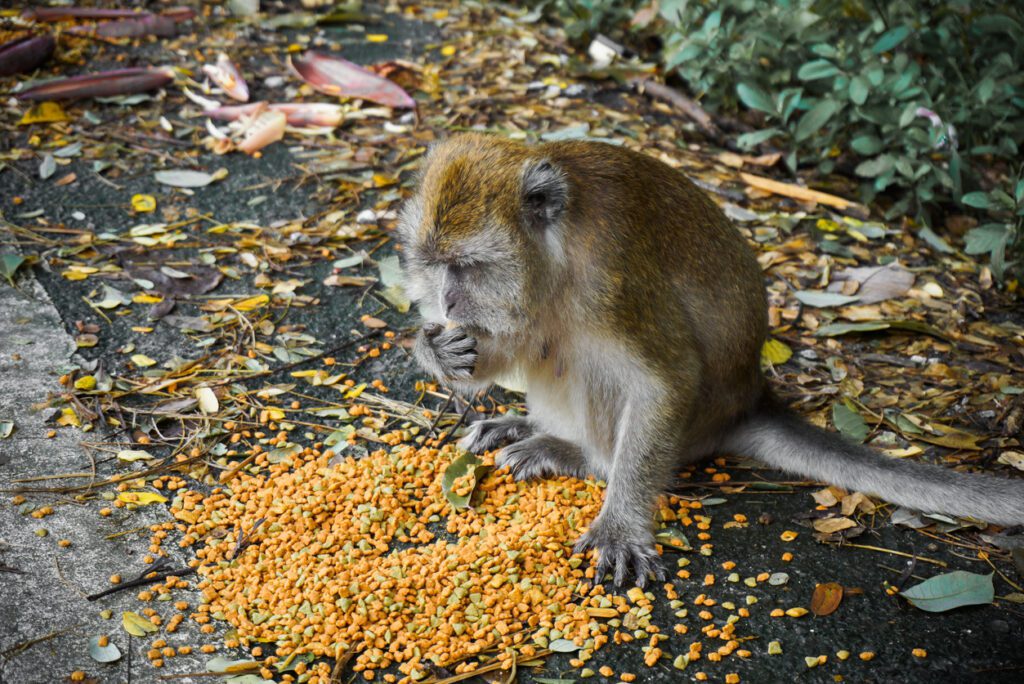
Unnatural nutritional guidelines for primates in captivity in the veterinary field?!
Veterinary research – in contrast to biology primate research – seems to perceive apes as typical omnivores, instead of the frugivorous omnivores that they actually are in nature! Some food recommendations for primate nutrition are highly questionable in the light that most primates are frugivorous.
Here’s an example from a veterinary manual with my thoughts on it:
“To prevent high amounts of easy digestible sugars (My comment: they talk about simple sugars from fruits!), which can cause diarrhea and obesity (My comment: natural fruits do not cause those problems in healthy primates), low amounts (< 10%) or no fruits should be fed (My comment: under 10% of fruits seems not biologically appropriate for species that eat around 70% fruits in the wild), and moderate amounts of carrot, sweet potato and apple (My comment: those particular plant foods do not occur in their natural habitat and should be seen as an addition to tropical fruits and foods!), should be offered, depending on the species. Feeding greens and green vegetables, which are more comparable to the natural diet (My comment: this is not in line with any of the academic primate research literature I have come across), should be encouraged. Monkey biscuits, high-fiber pellets for primates, and the canned products (My comment: sounds like highly-processed foods for primates instead of natural food sources) should comprise 20% of the dry-matter intake of gorilla and orangutan diets; fruits and treat items should comprise ≤10%, depending of the species (My comment: like this the apes are deprived of their primary energy source – simple sugars from tropical fruits), and green vegetables and browse should be at least 40% of the diet. “
Those recommendations are not in accordance with anything we can read in biological research on primate nutrition and diets! Here two examples that sharply contrast the above recommendations:
“Chimpanzees are frugivorous primates that mainly subsist on ripe fruit that is typically low in available protein and high in easily digestible carbohydrates.“
Uwimbabazi et al, 2021
“Almost without exception, extant apes and monkeys take the greatest proportion of their daily diet from plant foods – new leaves, ripe fruits, seeds, exudates, nectars, flowers, pith … the chimpanzee annual diet is composed in large part of ripe fruits.”
Prof. Kathrine Milton
Hopefully, zoos do not really follow the recommendations of commercially-driven advisors that deprive primates of the very foundation of their natural diet as frugivores: fruits! However, reality shows that this is often not the case.
A nutritional plan that does not match the natural diet is more likely to cause health problems… and who loses are the animals! Primatologists and academic researchers like Kathrine Milton (and others) who know the frugivory nature of primates should be the go-to experts to avoid the suffering of primates in captivity!

Is it “only” due to the high cost and difficult fruit availability?
Maybe the reason that primates are fed pellets and low-fruit diets is cost… but then, aren’t zoos a costly enterprise generally? It still does not justify not feeding primates the foods that they naturally eat and need…
One reason might be that proper ape feeding would remind us a lot about our own frugivorous nature! I won’t go into the depth of this topic, as it is linked to nutrition health and involves more than one huge industry that has never “liked” raw diets in particular, because of their potential to alleviate humans from many chronic conditions – for free.

Are zoos in colder climate really able to keep apes?
Most primates are tropical species! That primates are adapted to tropical climates also means that they are adapted to tropical foods -and thus wild-growing tropical fruits! (And there are obviously more factors, like the lack of sunshine – vitamin D – temperature, and moisture.)
Tropical foods are not only different in terms of plant species that they eat and fruit types but also in mineral abundance. The micronutrient profile in wild tropical fruits and food sources is different than the ones grown in colder climates!
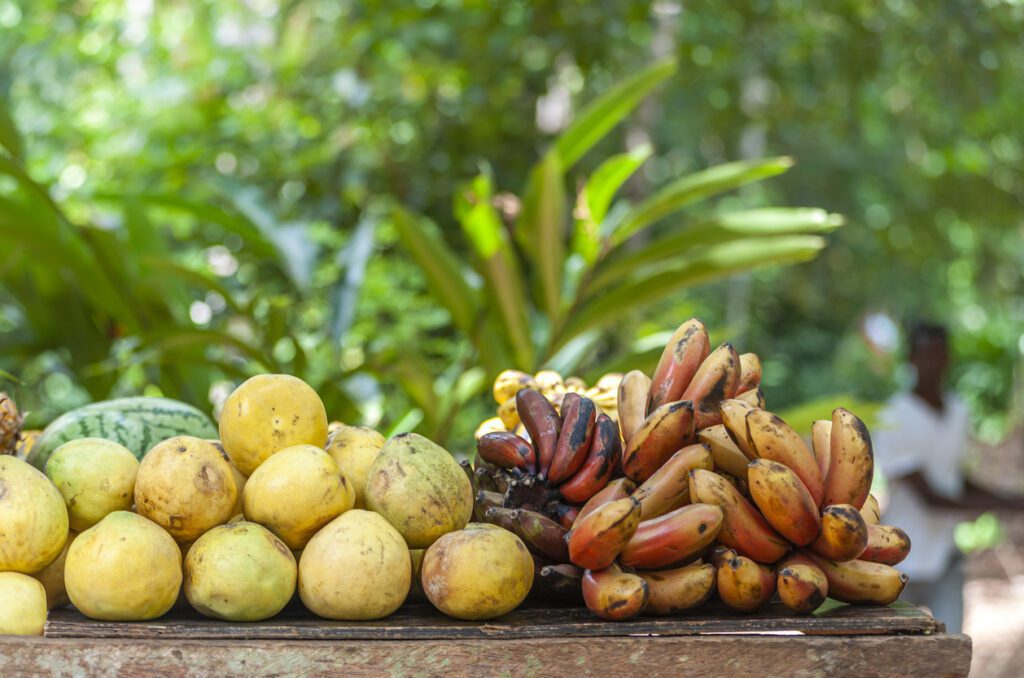
Primates in Zoos struggle with similar nutritional challenges as humans, and there are high chances that they run into deficiencies.

Apes need an abundance of tropical fruits in their diet, and if possible, the opportunity to forage in a tree setting. Thus, those conditions are very hard to establish within an artificially established setting of tropical forests. In my opinion, this is what is necessary to keep apes and primates happy and healthy in captivity!
References
- Primate problems (no date) Born Free. Available at: https://www.bornfree.org.uk/articles/primate-problems (Accessed: 30 June 2023).
- Welfare of Primates: Physical health (2021) nidirect. Available at: https://www.nidirect.gov.uk/articles/welfare-primates-physical-health#:~:text=Primates%20in%20captivity%20can%20develop,cause%20deformities%20of%20the%20skeleton. (Accessed: 30 June 2023).
- F. Carlsen et al. (2022) EAZA Best Practice Guidelines Great Ape Taxon Advisory Group Chimpanzees (Pan troglodytes). Available at: https://www.eaza.net/assets/Uploads/CCC/BPG-2022/Chimpanzee-BPG22.pdf (Accessed: 30 June 2023).
- Dani Sarusi, 10 things chimpanzees eat. Jane Goodall (2022) (available at https://janegoodall.ca/our-stories/10-things-chimpanzees-eat/).
- Smith-Spark, L. and Dewar, K. (2014) UK’s Paignton Zoo bans monkeys from eating bananas for health reasons, CNN. Available at: https://edition.cnn.com/2014/01/15/world/europe/uk-zoo-monkeys-bananas/index.html (Accessed: 30 June 2023).
- K. Milton, Nutritional characteristics of wild primate foods: Do the diets of our closest living relatives have lessons for us? Nutrition. 15, 488–498 (1999), doi:10.1016/s0899-9007(99)00078-7
- Amini Khoozani A, Birch J, Bekhit AEA. Production, application and health effects of banana pulp and peel flour in the food industry. J Food Sci Technol. 2019 Feb;56(2):548-559. doi: 10.1007/s13197-018-03562-z. Epub 2019 Feb 8. PMID: 30906012; PMCID: PMC6400781.
- Isnaeni, I., Zufara, B.S. and Lewa, I.W. (2020) ‘Alternative optical methods for qualitative detection of vitamin B6 and B12 of Banana’, Jurnal Teknologi dan Industri Pangan, 31(2), pp. 147–154. doi:10.6066/jtip.2020.31.2.147.
- Oyeyinka, B.O.; Afolayan, A.J. Suitability of Banana and Plantain Fruits in Modulating Neurodegenerative Diseases: Implicating the In Vitro and In Vivo Evidence from Neuroactive Narratives of Constituent Biomolecules. Foods 2022, 11, 2263. https://doi.org/10.3390/foods11152263
- S. Ross et al. (2009) Chimpanzee (Pan troglodytes) Care Manual. Assets.speakcdn.com. Available at: https://assets.speakcdn.com/assets/2332/chimpanzeecaremanual2010r.pdf (Accessed: 30 June 2023).
- R. Fulk et al. (1992) The Care and Management of Chimpanzees in Captive Environments. Available at: https://nagonline.net/wp-content/uploads/2013/12/Chimpanzee-Nutrition.pdf (Accessed: 30 June 2023).
- Nijboer, J. (2023) Nutrition in primates – management and Nutrition, MSD Veterinary Manual. Available at: https://www.msdvetmanual.com/management-and-nutrition/nutrition-exotic-and-zoo-animals/nutrition-in-primates (Accessed: 30 June 2023).
- Uwimbabazi, M. et al. (2021) ‘Nutritional geometry of female chimpanzees (pan troglodytes)’, American Journal of Primatology, 83(7). doi:10.1002/ajp.23269.

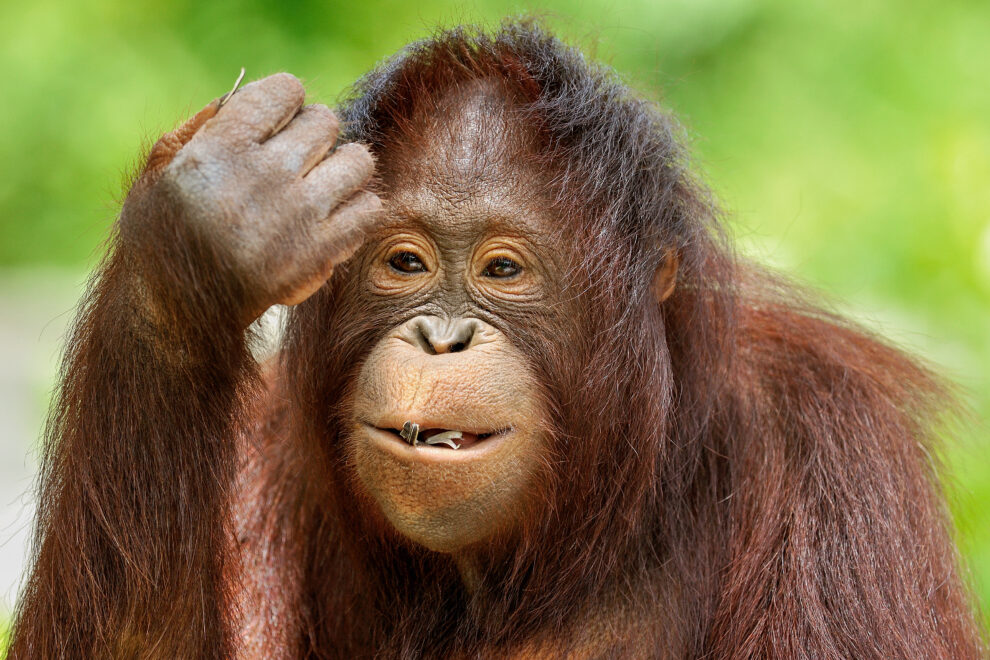
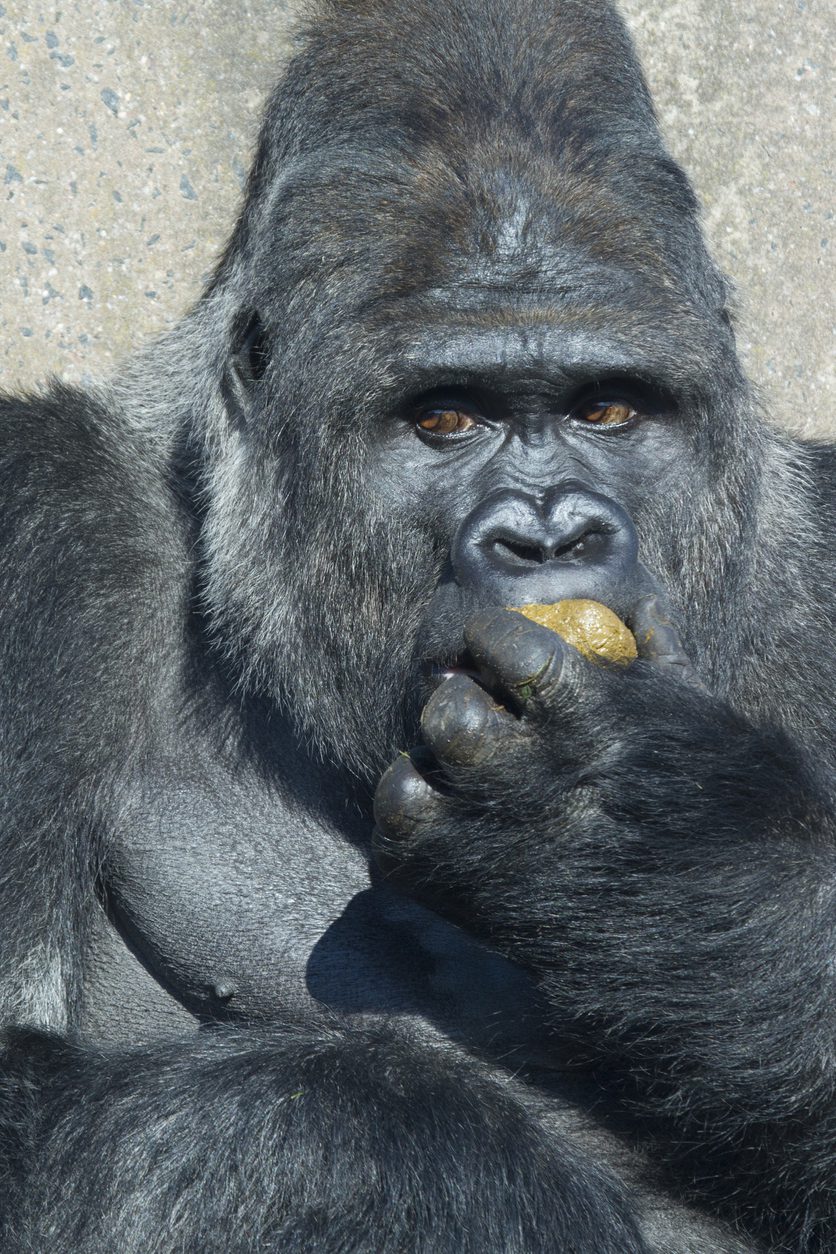

Add Comment